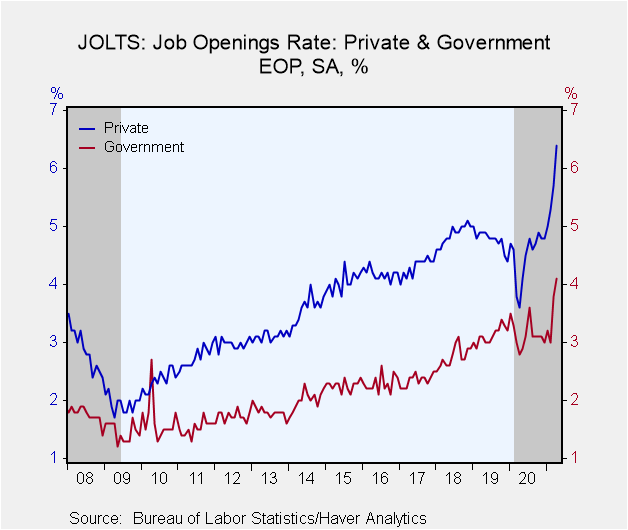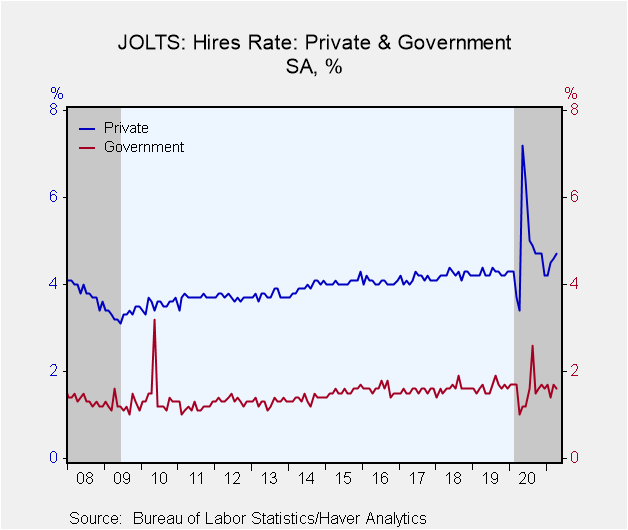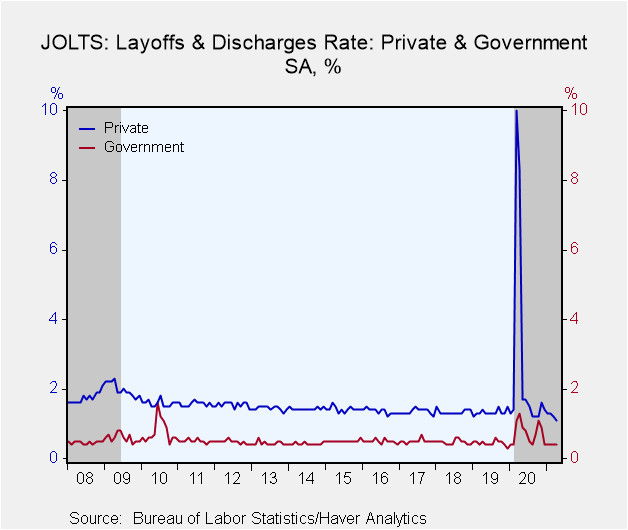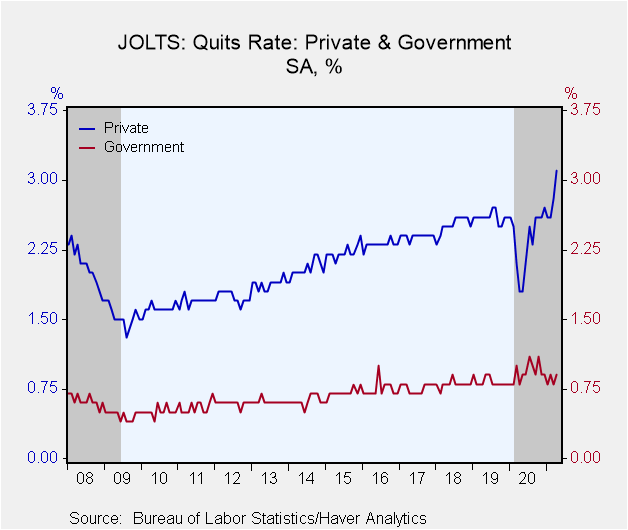 Global| Jun 08 2021
Global| Jun 08 2021U.S. JOLTS: Job Openings Rate & Level Surge to Records During April
by:Tom Moeller
|in:Economy in Brief
Summary
• Job openings rate strengthens across industries. • Hiring rate holds steady. • Layoffs decline while quits increase. The Bureau of Labor Statistics reported that on the last business day of April, the level of job openings rose to a [...]
• Job openings rate strengthens across industries.
• Hiring rate holds steady.
• Layoffs decline while quits increase.
The Bureau of Labor Statistics reported that on the last business day of April, the level of job openings rose to a record 9.286 million and have doubled y/y. The total job openings rate also reached a record 6.0%, which was increased from an unrevised 5.4% in March. The openings rate is calculated as job openings as a percent of total employment plus jobs that have not yet been filled. The hiring rate held steady m/m at 4.2% which was up from 3.8% in December & January. The overall layoff & discharge rate eased to a record low of 1.0% from an upwardly-revised 1.1% in March. The quits rate surged to a record high of 2.7% as the number of quits have risen 17.9% during the last six months. The JOLTS figures date back to December 2000.
The private-sector job openings rate jumped to a record 6.4% from 5.7% in March. The leisure & hospitality rate surged to a record 10.1% from 8.0% while the professional & business services rate strengthened to 6.8%. The factory sector job openings rate surged to a record 6.5% but the education & health services rate held at 5.8%. The government sector job openings rate also jumped to a record 4.1% from 3.8% in March. The private sector job openings level surged 12.5% and has more-than doubled y/y to 8.374 million.
Employers are having trouble finding workers as hiring is lagging job openings. In April, the private sector hiring rate rose to 4.7% and equaled the level six months earlier. It was well below the record 7.2% in May of last year. The leisure & hospitality hiring rate jumped 10.1%, equaling the openings rate. The professional & business service sector hiring rate fell to 5.1% the lowest level since May of last year. The construction sector's hiring rate weakened to 4.5% from 5.9% in March, and the factory sector hiring rate fell to 3.2% from 3.5%. The government sector hiring rate edged lower to 1.6%. It remained below the 2.6% high last August. The level of private sector hiring rose 1.5% (54.1% y/y) to 5.728 million.
Data on job separations reflect a combination of layoffs and quits. The separations rate of 4.0% in April compared to the record 10.8% in March of last year. The level of separations declined by one-half y/y. Private sector separations fell 51.8% y/y and the private separations rate rose to 4.4%, a five month high. The government's separation rate held steady at 1.6% for the third straight month.
The layoff & discharge rate in the private sector slipped to a record low of 1.1%. The professional & business services layoff & discharge rate fell to 1.5% and was down from an all-time high of 6.3% in April of last year. The 2.1% rate in construction compared to 0.8% in manufacturing. The 1.0% rate in the information sector remained below the record 6.8% in March of last year. It compared to 0.4% in government, where it's been for five months.
As the labor market firms, workers look for new job opportunities. The record quits rate of. 3.1% in the private sector remained up from 1.8% in April and May last year. It compared to 0.9% in government. In the leisure & hospitality sector, the quits rate surged to a near-record 5.3%. The quits rate in professional & business services surged to 3.4%, equaling the record high. In manufacturing, the job quits rate also surged to a record 2.3% and remained up from 1.0% in April of last year. In finance, the quits rate edged higher m/m to 1.5%. The level of job quits in the private sector nearly doubled y/y. In government, the level of quits rose 13.9% y/y.
The Job Openings and Labor Turnover Survey (JOLTS) are available in Haver's USECON database.
| JOLTS (Job Openings & Labor Turnover Survey, SA) | Apr | Mar | Feb | Apr'20 | Apr'19 | Apr'18 |
|---|---|---|---|---|---|---|
| Rate (%) | 6.0 | 5.4 | 5.0 | 3.4 | 4.6 | 4.4 |
| Total (000s) | 9,286 | 8,288 | 7,526 | 4,630 | 7,257 | 6,910 |
| Hires, Total | ||||||
| Rate (%) | 4.2 | 4.2 | 4.0 | 3.0 | 4.0 | 3.8 |
| Total (000s) | 6,075 | 6,006 | 5,794 | 3,942 | 6,051 | 5,610 |
| Layoffs & Discharges, Total | ||||||
| Rate (%) | 1.0 | 1.1 | 1.2 | 7.2 | 1.3 | 1.2 |
| Total (000s) | 1,444 | 1,525 | 1,723 | 9,307 | 1,954 | 1,741 |
| Quits, Total | ||||||
| Rate (%) | 2.7 | 2.5 | 2.4 | 1.6 | 2.3 | 2.3 |
| Total (000s) | 3,952 | 3,568 | 3,383 | 2,107 | 3,494 | 3,366 |
Tom Moeller
AuthorMore in Author Profile »Prior to joining Haver Analytics in 2000, Mr. Moeller worked as the Economist at Chancellor Capital Management from 1985 to 1999. There, he developed comprehensive economic forecasts and interpreted economic data for equity and fixed income portfolio managers. Also at Chancellor, Mr. Moeller worked as an equity analyst and was responsible for researching and rating companies in the economically sensitive automobile and housing industries for investment in Chancellor’s equity portfolio. Prior to joining Chancellor, Mr. Moeller was an Economist at Citibank from 1979 to 1984. He also analyzed pricing behavior in the metals industry for the Council on Wage and Price Stability in Washington, D.C. In 1999, Mr. Moeller received the award for most accurate forecast from the Forecasters' Club of New York. From 1990 to 1992 he was President of the New York Association for Business Economists. Mr. Moeller earned an M.B.A. in Finance from Fordham University, where he graduated in 1987. He holds a Bachelor of Arts in Economics from George Washington University.












